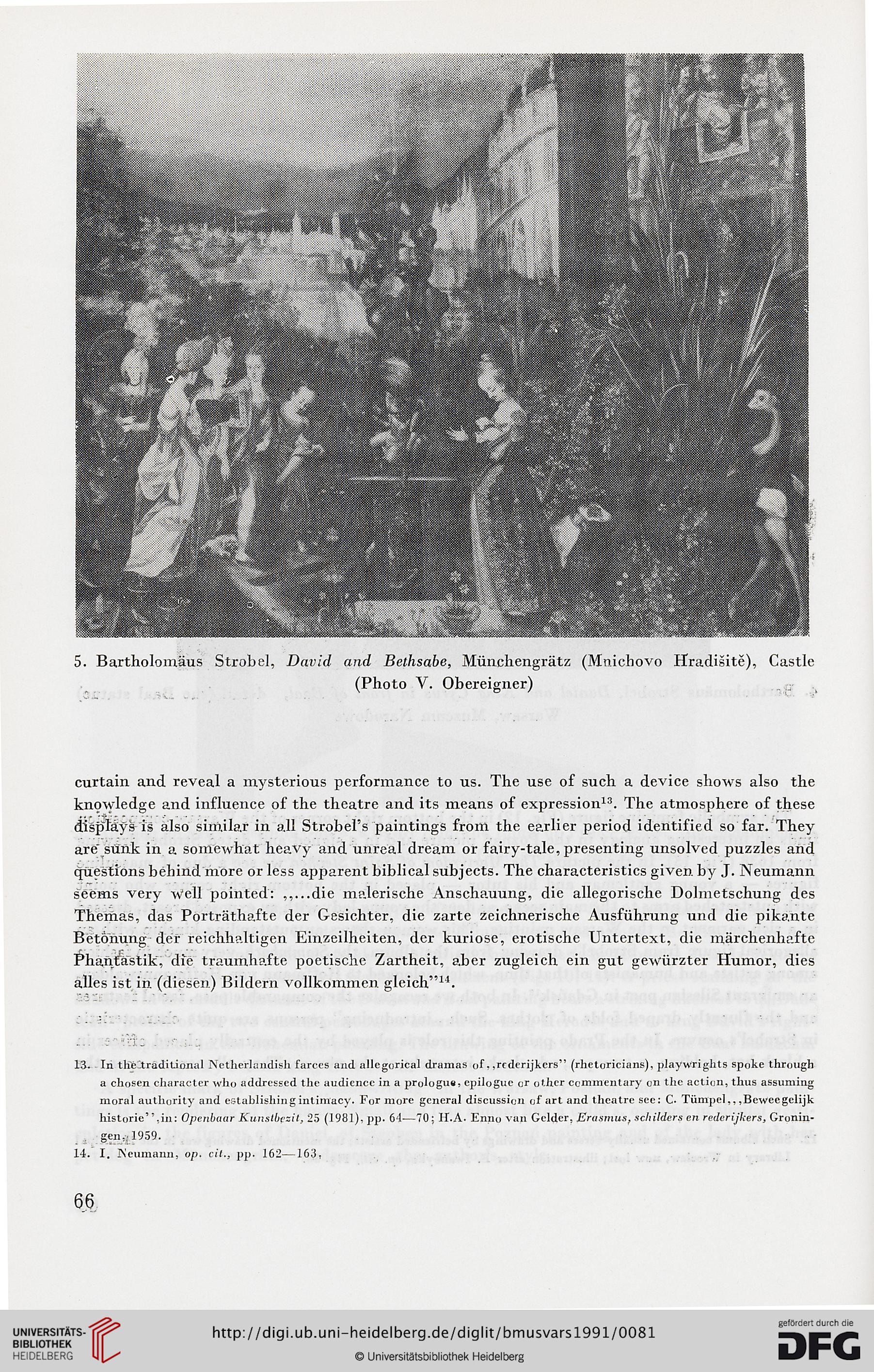5. Bartholomaus Strobel, David and Bethsabe, Miinchengratz (Mnichovo Hradiśite), Castle
(Photo V. Obereigner)
curtain and reveal a mysterious performance to us. The use of such a device shows also the
knowledge and influence of the theatre and its means of expression13. The atmosphere of these
displays iś also siniilar in all Strobel's paintings from the earlier period identified so far. They
are' suńk in a somewhat heavy and unreal dream or fairy-tale, presenting unsolved puzzles and
queśtions behind more or less apparent biblical subjeets. The characteristics given by J. Neumann
śeems very "Weil pointed: ,,...die malerische Anschauung, die allegorische Dolmetschung des
Therńas, das Portrathafte der Gesichter, die zarte żeichnerische Ausfiihrung und die pikante
Betónung der reichhaltigen Einzeilheiten, der kuriose, erotische Untertext, die marchenhafte
Phanf&stik, die traumhafte poetische Zartheit, aber zugleich ein gut gewiirzter Humor, dies
alles ist in (diesen) Bildern vollkommen gleich"14.
13. - In theltradiLional Netherlśńjdish farces and allegorićal dramas of. ,rtdtrijkcrs1' (rhetoricians), playwrights spoke thrnugh
a chosen character who addressed the audience in a prologu*, epilogue or other commoitary on the action, thus assuming
morał authority and establishin g intimacy. For more generał discussion of art and theatre see: C. Tiimpel,, ,Beweegelijk
historie" .in: Openbaar Kunsibfsit, 25 (1981). pp. 64—70; H.A. Enno van Gelder, Erasmus, schilders en rederijkers, Gronin-
i g«n>(l''59. • - . .
14. I. Neumann, op. cii., pp. 162—163,
66
(Photo V. Obereigner)
curtain and reveal a mysterious performance to us. The use of such a device shows also the
knowledge and influence of the theatre and its means of expression13. The atmosphere of these
displays iś also siniilar in all Strobel's paintings from the earlier period identified so far. They
are' suńk in a somewhat heavy and unreal dream or fairy-tale, presenting unsolved puzzles and
queśtions behind more or less apparent biblical subjeets. The characteristics given by J. Neumann
śeems very "Weil pointed: ,,...die malerische Anschauung, die allegorische Dolmetschung des
Therńas, das Portrathafte der Gesichter, die zarte żeichnerische Ausfiihrung und die pikante
Betónung der reichhaltigen Einzeilheiten, der kuriose, erotische Untertext, die marchenhafte
Phanf&stik, die traumhafte poetische Zartheit, aber zugleich ein gut gewiirzter Humor, dies
alles ist in (diesen) Bildern vollkommen gleich"14.
13. - In theltradiLional Netherlśńjdish farces and allegorićal dramas of. ,rtdtrijkcrs1' (rhetoricians), playwrights spoke thrnugh
a chosen character who addressed the audience in a prologu*, epilogue or other commoitary on the action, thus assuming
morał authority and establishin g intimacy. For more generał discussion of art and theatre see: C. Tiimpel,, ,Beweegelijk
historie" .in: Openbaar Kunsibfsit, 25 (1981). pp. 64—70; H.A. Enno van Gelder, Erasmus, schilders en rederijkers, Gronin-
i g«n>(l''59. • - . .
14. I. Neumann, op. cii., pp. 162—163,
66




